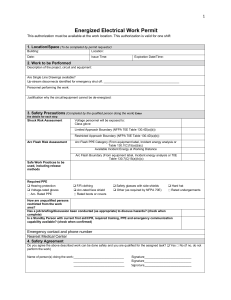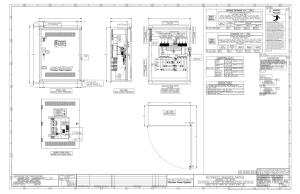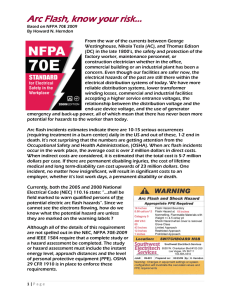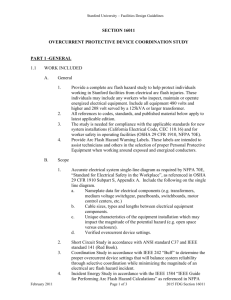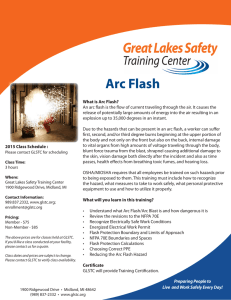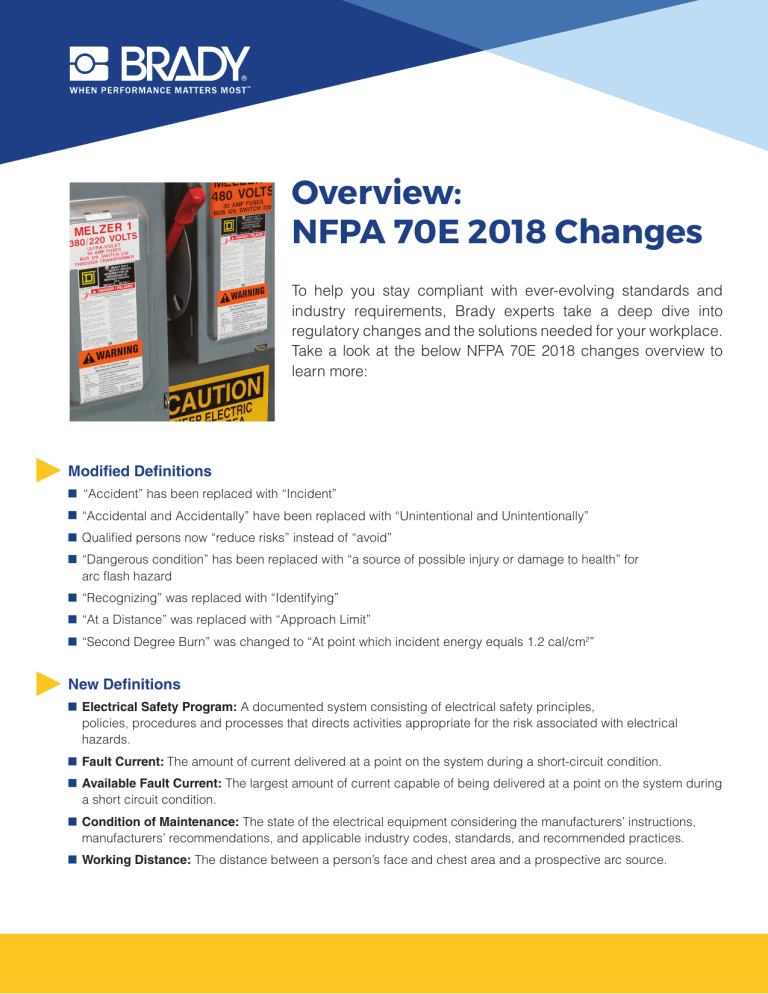
Overview: NFPA 70E 2018 Changes To help you stay compliant with ever-evolving standards and industry requirements, Brady experts take a deep dive into regulatory changes and the solutions needed for your workplace. Take a look at the below NFPA 70E 2018 changes overview to learn more: Modified Definitions OO “Accident” has been replaced with “Incident” OO “Accidental OO Qualified and Accidentally” have been replaced with “Unintentional and Unintentionally” persons now “reduce risks” instead of “avoid” OO “Dangerous condition” has been replaced with “a source of possible injury or damage to health” for arc flash hazard OO “Recognizing” OO “At was replaced with “Identifying” a Distance” was replaced with “Approach Limit” OO “Second Degree Burn” was changed to “At point which incident energy equals 1.2 cal/cm2” New Definitions Safety Program: A documented system consisting of electrical safety principles, policies, procedures and processes that directs activities appropriate for the risk associated with electrical hazards. OO Electrical OO Fault Current: The amount of current delivered at a point on the system during a short-circuit condition. Fault Current: The largest amount of current capable of being delivered at a point on the system during a short circuit condition. OO Available of Maintenance: The state of the electrical equipment considering the manufacturers’ instructions, manufacturers’ recommendations, and applicable industry codes, standards, and recommended practices. OO Condition OO Working Distance: The distance between a person’s face and chest area and a prospective arc source. Changes by Section 105 – Application of Safety-Related Work Practices and Procedures 110 – General Requirements for Electrical Safety-Related Work Practices 110.1 – Electrical Safety Program Previously just addressed employer, now subdivided: • Employer: establish, document and provide TRAINING • Employee: must comply with safety related work practices and procedures provided by the employer New text indicating that the first PRIORITY in the implementation of safety-related work practices shall be hazard elimination. Heavily reorganized to put more importance on the electrical safety program and training. Added a need for inspection of new or revised equipment before being placed into service. Risk assessment procedure: • Must address the potential for human error and incorporate a hierarchy or risk control methods • Brand NEW Annex Q Also new sections related to Job Safety Planning, Job Briefing, Change in Scope and Incident Investigations. Reorganized to create a more logical sequence for the overall lockout tagout process. 110.2 – Training Requirements NEW exception for “Simple Procedures”: Lockout tagout is not required for work on cord and plug connected equipment for which exposure to the hazards of unexpected energization of the equipment is controlled by the unplugging of the equipment from the energy source, provided that the plug is under the exclusive control of the employee performing the servicing and maintenance for the duration of the work. The “process” as outlined in 120.5 added 2 steps: • Release stored electrical energy • Release or block stored mechanical energy Shock Risk Assessment was modified to require documentation and more information regarding additional protective measures. 130 – Work Involving Electrical Hazards Arc Flash Risk Assessment was modified similarly to identify hazards, estimate the likelihood of occurrence and if additional protective measures are required. (Table 130.5(C) can now be used for both methods). The incident energy analysis shall be reviewed for accuracy at intervals not to exceed 5 years. 130.5(G) This table can be used with the incident energy analysis method for selecting arc flash PPE. The table used to be in Annex H in 2015, but due to incorrect use of PPE, so it was moved to the required text. 130.5(H) – Equipment Labeling Unless changes in electrical distribution system(s) render the label inaccurate, labels applied prior to the effective date of this edition of the standard shall be acceptable if they complied with the requirements for equipment labeling in the standard in effect at the time the labels were applied. 130.7(A) – Personal and Other Protective Equipment / General Removal of information note regarding de-energizing when incident energy exceeds 40 cal/cm2. 130.7(C)(14) – Standards for PPE 2015 required that standards listed in Table 130.7(C)(14) were met. 2018 indicates that PPE must also conform to applicable state, federal, or local codes and standards Q&As You asked – and we’re answering! Find the answers to some of the more frequently asked NFPA 70E questions here: When does NFPA 70E 2018 go into effect? NFPA 70E is not technically a code, so adoption depends on the Authority Having Jurisdiction (AHJ). It is generally accepted that January 1 of the listed year is when it takes effect. Arc flash data reviews should not exceed 5 years. How extensive should these reviews be? Any and all changes should be discovered in the review. The utility company should also be contacted to ensure fault current is still the same. If absolutely no changes have been made, then the review will be simple. Does a typical industrial machine require an arc flash label? If there is a potential for the equipment control panel to require examination, adjustment, servicing or maintenance while energized, then it shall be marked with a label. An assessment is needed. What should be included on an arc flash label? Learn more about what should appear on an arc flash label at BradyID.com/arcflash Who should be trained? Electrical safety training should be given to all employees who face a risk of electric shock. Can a safety champion be a qualified person to train employees? Yes. We perform train-the-trainer for our clients. The training delivered to your employees has to meet your standards and requirements for what you feel they need to be safe. Learn more about Arc Flash Training. What is the definition of a qualified person? One who has demonstrated skills and knowledge related to the construction and operation of electrical equipment and installations and has received safety training to identify the hazards and reduce the associated risk. Can an employee with no electrical certification open a panel board to shut on-off shop lights? If everything is installed properly, maintained and in proper working order, then no hazard should exist and this is not considered live work. What are common arc flash hazards, and at what level of voltage should arc flash be a concern? Any time there are exposed/energized conductors or circuit parts there is an arc flash and shock hazard. OSHA and NFPA 70E both define 50V as the threshold where a risk exists. In order to open the cover of an electrical panel, does the power need to be turned off and an arc flash suit worn? Yes. Per Table 130.5(C), Opening hinged door(s) or cover(s) or removal of bolted covers (to expose bare,energized electrical conductors and circuit parts) is an increase in likelihood of occurrence and requires the use of additional protective measures (PPE). Is the lowest PPE category now “Category 1”? If the PPE Categories Method is used, then yes, “Category 0” no longer exists and this should be increased to “Category 1”. If calculations are done as per the incident energy analysis method and the results are less than 1.2 calories per centimeter squared, then in practice you would be wearing PPE similar to the old “Category 0”. However, when calculations are performed PPE is not Categorized. Can a facility use a combination of Incident Energy Analysis and PPE Category Methods? Yes, a facility can use both methods as long as the labels indicate the results clearly. What are the qualifications for the individual conducting the risk assessment? It depends on the requirements of the local Authority Having Jurisdiction (AHJ). Having a professional engineer perform or oversee the assessment is always a good thing. In many cases though, if the consultant has the experience and knowledge to perform the assessment, that is fine. OSHA and NFPA 70E do not address this. Do all electricians/technicians who are involved in 70E need to have CPR/first aid training? According to NFPA, if the person is responsible for responding to medical emergencies, then they should have first aid and CPR training. Were the changes from 2015 to 2018 editions driven by electrical incident investigation data? The changes are meant to improve and increase compliance with an emphasis on safety. Electrical safety programs are now entailed to include a new section on how to investigate electrical incidents/accidents in a facility. Is hazard elimination the same as the hierarchy of controls? Yes, hazard elimination shall be the first priority in the implementation of safety-related work practices. Elimination is the risk control method listed first in the hierarchy of risk control identified in 110.1(H). Visit BradySafety.com to learn about our Arc Flash services. © 2017 Brady Worldwide Inc. ALL RIGHTS RESERVED USA Customer Service: 1-888-272-3946 Inside Sales: 1-888-311-0775 BradyID.com Canada Customer Service: 1-800-263-6179 BradyCanada.ca Mexico Customer Service: 1-800-262-7777 Inside Sales: 1-800-262-7777 ext 177 BradyLatinAmerica.com
